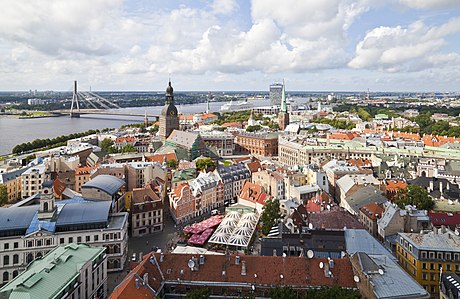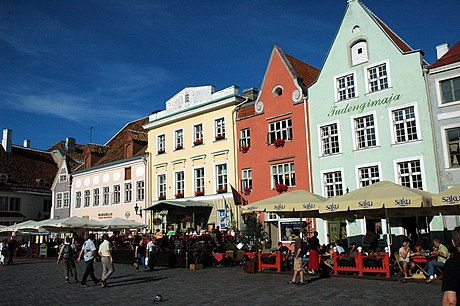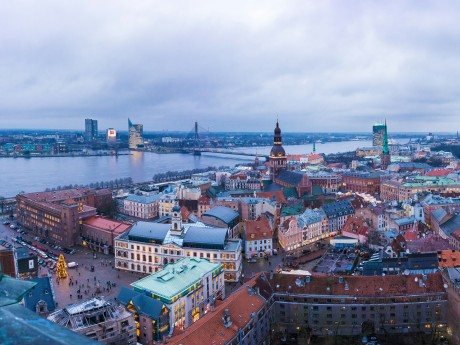Latvia & Estonia: Riga and Tallinn
Embark on a journey through the enchanting Baltic nations of Latvia and Estonia, where time seems to stand still amidst the medieval cobblestone streets, architectural marvels, and a rich tapestry of cultural experiences waiting to be discovered. In Riga, stroll through the UNESCO-listed Old Town which reveals a stunning array of medieval buildings, including the iconic Riga Cathedral.
Read more
Embark on a journey through the enchanting Baltic nations of Latvia and Estonia, where time seems to stand still amidst the medieval cobblestone streets, architectural marvels, and a rich tapestry of cultural experiences waiting to be discovered. In Riga, stroll through the UNESCO-listed Old Town which reveals a stunning array of medieval buildings, including the iconic Riga Cathedral. Immerse yourself in the city's past by exploring the Latvian Ethnographic Open-Air Museum, visit the Central Market for local delicacies and handmade crafts or take a leisurely boat cruise along the Daugava River. Your multi-country journey continues to Estonia. In Tallinn, see the orthodox Alexander Nevsky Cathedral which impresses with its Russian revival style of the late 1800s and Tallinn Old Town, the oldest in North Europe. Viru Gate, located nearby, remains one of the city's most picturesque landmarks. Lennusadam (the maritime museum) and the Kadriorg Art Museum also offer visitors insight into the city's past while Kadriorg Park features stunning symmetrical designs leading to the Kadriorg Palace. Waterviews strives to offer accommodation options within walking distance of water and/or in an area of touristic interest. Our prices include taxes (but excludes local tourist taxes). Customize your trip to your personal preferences with optional activities (hit the “Add Activities’’) or change hotels, etc. Contact us for customization at no extra cost at: Service@waterviewstravel.com
<b
Destinations
- Riga
- Tallinn
Itinerary
Riga

Riga is the financial, creative, and cultural center of Latvia. It is the capital and the largest city in Latvia, it is also the largest city in the Baltic States. The city lies on the Gulf of Riga, at the mouth of Daugava, Riga has an population of approximately 640,000 inhabitants, or 1/3 of the population of Latvia. The city was part of many empires throughout history, each of which has left its mark on the city. It is famous for Art Nouveau and wooden architecture. Riga's historical center is listed as a UNESCO World Heritage site.
Read more
Riga is the financial, creative, and cultural center of Latvia. It is the capital and the largest city in Latvia, it is also the largest city in the Baltic States. The city lies on the Gulf of Riga, at the mouth of Daugava, Riga has an population of approximately 640,000 inhabitants, or 1/3 of the population of Latvia. The city was part of many empires throughout history, each of which has left its mark on the city. It is famous for Art Nouveau and wooden architecture. Riga's historical center is listed as a UNESCO World Heritage site.
Additional Information
Riga is famous for its world heritage-listed old town (Vecrīga) and city center (Centrs), in which over 800 buildings — a third of all buildings — are of the Art Nouveau (aka Jugendstil) style of architecture and thus Riga is one of the best destinations to see this architectural style. Chiefly built in the first years of the 20th century, many of Riga's Art Nouveau buildings were created by ethnic Latvian architects unlike earlier buildings in the city . The Art Nouveau style involves intricate building facades, with carvings of flowers and mythological creatures, and ornate doorways and windows.
A considerable part of the old town was either destroyed by fire or destroyed by the Germans in World War II but many old buildings were also spared. The old town was a draw of the city during the Soviet times and it received protected status in 1967. The damaged parts, most notably the House of the Blackheads, were restored in the late 1990s, mainly to make Riga more attractive as a tourist destination. Another thing that attracts visitors, especially young adults, is the lively nightlife and discount airlines that offer cheap flights to/from much of Europe.
Riga is bisected by the river Daugava. Old (medieval) town is in the center of the city on the east side of the river. It is surrounded by a ring of ~19th–early 20th-century architecture including the Art Nouveau buildings described above, followed by a mix of private 2-floor house districts (many also pre-World War II) and Soviet-era 5-18 floor apartment districts. Especially near railroad lines, they are interspersed with industrial plants from different eras, including some from the Imperial Russian era.
History
Riga was founded in 1201 by Albert of Bremen as a port city and a base to conquer and convert the native Livonians to Christianity, a goal that was achieved in 1206 after a battle in Turaida during the Northern Crusades. Riga developed as the major trade hub of the area during the peak of the Hanseatic League in the 13th to the 15th centuries and was ruled by the Archbishop of Riga. The Reformation reached Riga in 1522, which ended the Archbishops' power. In 1621, Riga became part of the Kingdom of Sweden, although it maintained a great deal of autonomy. In 1710, an invasion by Peter the Great of Russia ended Swedish rule and cemented Russian influence on the city.
Latvia declared its independence on November 18, 1918. It was annexed by the Soviet Union in 1940. Riga served as the capital of the Latvian Soviet Socialist Republic.
Germans have inhabited the city since its establishment by Albert, and throughout most of its history, Germans were the elite while Latvians remained a lower class. The Germans' position as the elite continued through the Imperial period of Riga, visible in some of the architecture of the city. The Germans were forcibly evicted after the Nazi occupation of 1941-44.
Talk
The official language of Latvia is Latvian; however, in Riga, the majority of the population speaks both Latvian and Russian. English is widely spoken by younger people and by people in the tourism industry. German is also commonly spoken by tour guides.
© Sourced from Wikivoyage
Tallinn

Tallinn is Estonia's capital and largest city. On the shore of the Gulf of Finland, it is a city of over 400,000 inhabitants. It is home to a third of the country's population, and is also the capital of Harju County in Northern Estonia.
Read more
Tallinn is Estonia's capital and largest city. On the shore of the Gulf of Finland, it is a city of over 400,000 inhabitants. It is home to a third of the country's population, and is also the capital of Harju County in Northern Estonia.
Additional Information
Tallinn has been and continues to be an important port of the Baltic Sea, with the busy passenger section of the port reaching the foothill of the picturesque medieval Old Town, which has been astonishingly well preserved and was inscribed on the UNESCO World Heritage List in 1997. In a striking contrast, the immediate outskirts thereof are filled with a cluster of modern office towers, with intermittent architectural monuments to the Soviet era. Further out, you will find a bewildering variety of historic and modern neighbourhoods, religious, civic, industrial and maritime heritage. This all provides for the city seeing very sizeable tourist traffic given its size, which in turn means the infrastructure is robust and extensive.
History
Tallinn is a historic city dating back to medieval times. The first fortress on Toompea was built around 1050 and Tallinn was possibly first recorded on a world map in 1154. In 1219, the city was conquered by Valdemar II of Denmark and it became a member of the Hanseatic League in 1285. The city, known as Reval at the time, prospered as a trading town in the 14th century, and much of Tallinn's historic centre was built at this time.
Tallinn then became a pawn in the geopolitical games of its big neighbours, passing into Swedish hands in 1561 and then to the Russian Empire under Peter the Great in 1710. By World War I and the ensuing brief Estonian independence (starting 1918) Tallinn's population had reached 150,000.
Estonia was occupied by the Soviet Union in 1940, conquered by Nazi Germany (1941–44), and then retaken by the Soviets. In World War II, the city was quite extensively bombed by the Soviets, although luckily the medieval town remains. The Soviet Union undertook a program of massive East Slavic migration, and just over 40% of Tallinn's current inhabitants are Slavic (compared to an average of 28% for the entire country). On 20 August 1991, Estonia declared independence and Tallinn became its capital once again.
Present day
Today Tallinn is a bustling, gleaming city of more than 400,000 inhabitants. However, among the tall glassy buildings and corporate headquarters, Tallinn retains an inner charm seldom found elsewhere. Estonia considers itself a Northern European/Nordic country, with very close ethnic, linguistic and cultural ties to Finland and cultural ties to Scandinavia, and visiting Tallinn you will find a mix of at least three architectures in this very visual city—old Europe (the city walls with rustic buildings and charming living areas with well-preserved and colourful wooden houses of bourgeois taste of 1920s), Soviet brutalist (concrete apartment blocks), and modern Europe (including McDonald's next to the city walls!)
Tourism is important for Tallinn and this is especially visible in the old town where almost every door leads into a souvenir shop, restaurant or bar. Unsurprisingly the majority of visitors are day trippers from Finland. The neighbours from across the bay usually know their way around without a map and have already seen the sights of Tallinn a couple of times. They come to enjoy low prices on practically all goods and services from restaurant meals to fuel and even plastic surgeries, not to forget as much alcohol as the customs regulations allow you to bring into Finland!
Districts
Tallinn is made up of 8 administrative districts (linnaosa), which are further divided into numerous quarters (asum). Most of the points of interest to tourists are located in the seaside districts. The districts of Tallinn are: Kesklinn - literally meaning "city centre" and being just what the label says, this district includes the main part of the Port of Tallinn, the Old Town (Vanalinn), Tallinn's central business district with its skyscrapers and many other tourist attractions in the quarters surrounding them, including the Kadriorg park and palace and most of the coastline of Lake Ülemiste except for the part immediately adjacent to the airport Haabersti - the westernmost district with the extensive coastline holds the Estonian Open Air Museum, the Tallinn Zoo and the Saku Suurhall Arena, as well as the city's largest shopping centre Põhja-Tallinn - literally meaning "north Tallinn", extends north of the railway line and includes the industrial part of the Port of Tallinn, as well as many monuments to its military heritage, the Maritime Academy and the quarter of Kalamaja known for its wooden houses Pirita - the least populous district of Tallinn stretches along the eastern part of its coast and includes both a popular beach and a forest. This is one of Estonia's most desirable places to live, in single-family houses, for the affluent, and home to some tourist attractions as well, including Tallinn's TV Tower or the Botanic Gardens Lasnamäe - the most populous district of Tallinn holds over a quarter of its inhabitants in the large Communist-era blocks of flats, but apart from the airport it has little of interest to the tourists Nõmme - formerly an independent town founded as a leisure/summer residence, Nõmme remains green and sparsely inhabited, with rich architectural heritage and many private villas. It ranks as one of the country's most affluent areas. Kristiine and Mustamäe are residential districts southwest of the centre.
Climate
At these latitudes winters are dark and cold and temperatures under -20°C are not unheard of from December to February. Thankfully, the sea moderates the winter temperatures a bit compared to continental cities with similar temperatures like Moscow.
Spring is the driest season and while there are often sub-zero temperatures at night until well into May, the snow usually disappears towards the end of March and the days are getting gradually warmer. Summer months are pleasant with day temperatures between +20°C and +30°C in July and August, however if it's raining, temperatures are lower. The summer is the best time of the year to visit Tallinn. Although Tallinn doesn't experience the Midnight Sun, in the middle of the summer it doesn't get really dark at night.
Usually you will need your jacket again towards the latter half of September. The autumn is the "rain season" and with both temperatures and the leaves falling, Tallinn doesn't look very attractive this time of the year. However the greyness is covered up by the snow that usually arrives in early December. Visiting Tallinn in December when the Old Town is beautifully covered in snow and Christmas decorations is not a bad idea.
Tourist office
© Sourced from Wikivoyage





